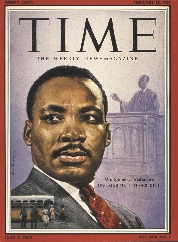

Martin Luther King, Jr., was featured on the cover of Time magazine in 1957.
The Montgomery Bus Boycott
For the next year, very few African Americans rode public buses in Montgomery, Alabama. Most used car pools to get to work. The boycott worked. The bus company lost a lot of money. The combination of the city’s loss of money and a decision by the Supreme Court forced the Montgomery Bus Company to accept integration.
In June 1956, a federal court ruled that the bus segregation in Alabama was against the Constitution. The city of Montgomery did not give in easily. Lawyers for the city took the case to the Supreme Court, but that November, the Supreme Court agreed that segregation on buses was not lawful in the case of Browder v. Gale. A little over a year after the day that Rosa Parks refused to move, the Montgomery buses were integrated.
The Montgomery bus boycott was big news. It made Martin Luther King, Jr., famous. Time magazine put him on the cover. Requests to speak poured in from all over the country, and the publicity also led to boycotts in many other parts of the South.
The Protests
In February 1960, four African American college freshmen in Greensboro, North Carolina, decided to take another step toward equality. They sat down at the